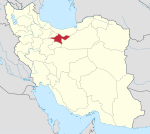Azadi Tower
| Azadi Tower | |
|---|---|
| برج آزادی | |
 | |
| General information | |
| Type | Cultural |
| Location | Tehran, Iran |
| Coordinates | 35°41′58″N 51°20′16″E / 35.69944°N 51.33778°ECoordinates: 35°41′58″N 51°20′16″E / 35.69944°N 51.33778°E |
| Completed | 1971 |
| Cost | $6 million [1] |
| Height | |
| Roof | 45 m (148 ft) |
| Design and construction | |
| Architect | Hossein Amanat |
| Structural engineer | Ove Arup & Partners [2] |
| Main contractor | MAP Company [3] |
| Website | |
| Azadi Tower, | |
The Azadi Tower (Persian: Borj e Āzādi – برج آزادی; "Liberty Tower"), formerly known as the Shahyad Tower (برج شهیاد – Borj e Šahyād; "King's Memorial Tower"), is a monument located at Azadi Square, in Tehran City, Iran. It is one of the symbols of Tehran, and marks the west entrance to the city.
Construction
The architect Hossein Amanat won a competition to design the building. He combined elements of the architecture of Sassanid and Achaemenid eras with the post-Islamic Iranian architecture.[4]
Amanat, a Baha'i, was driven from the country by the Revolution of 1979 and the removal of religious pluralism.[5]
The tower is part of the Azadi Cultural Complex, located in Tehran's Azadi Square in an area of about 50,000 m². There are several fountains around the base of the tower and a museum underground.
Built with white marble stone from the Isfahan Province, it includes eight thousand blocks of stone. The stones were all located and supplied by Ghanbar Rahimi, whose knowledge of the quarries was second to none and who was known as "Soltan e Sang e Iran" (Iran's Sultan of Stone). The shape of each block was calculated by computer, and programmed to include all the instructions for the building's work. The actual construction of the tower was carried out, and supervised by Iran's finest master stonemason, Ghaffar Davarpanah Varnosfaderani. The main financing was provided by a group of five hundred Iranian industrialists. The inauguration took place on October 16, 1971.
The iconic Monument des Martyrs in Algiers which was built in 1982, shows a strong influence by this monument, in its general design as well as its details.
History
The first known name associated with this monument was Darvaze-ye Koroush ("the Gate of Cyrus"), and at the time of the Centenary Celebrations, Assadollah Allam who chaired the Celebrations Council referred to the monument as Darvaze-ye Shahanshahi ("the Imperial Gate"). The monument's official name was decided before the announcement of the competition for the monument's design in September 1966. Bahram Farahvashi, a scholar and professor of ancient Iranian languages and cultures, who worked with the Celebrations Council, came up with the officially designated name of the structure Shahyad Aryamehr Monument.[6] Built in 1971 in commemoration of the 2,500th anniversary of the Persian Empire, this "gateway into Tehran" was named the Shahyad ("King's Memorial") in honor of the Shah, but was changed to Azadi ("Freedom") after the 1979 Revolution. It is 50 meters (164 ft) tall and completely clad in cut marble.[7][8]
Museum

The entrance to the tower is directly underneath the main vault and leads into the Azadi Museum on the basement floor. The black walls and proportions of the building are austere. Heavy doors open onto a crypt with subdued lighting issuing from showcases, each containing an object. Gold and enamel pieces, painted pottery, marble, miniature, and paintings are located among black marble walls. A concrete mesh forms the ceiling. Approximately fifty pieces have been selected, each representing a particular period in Iran's history.
The main display is occupied by a copy of the Cyrus Cylinder (the original is in the British Museum). A translation of the cuneiform inscription on the cylinder is inscribed in golden letters on the wall of one of the galleries leading to the museum's audio-visual department; opposite, a similar plaque lists the Twelve Points of the White Revolution. Next to the Cyrus Cylinder, there is a gold plaque commemorating the original presentation of the museum to Mohammad Reza Pahlavi by the Mayor of Tehran.
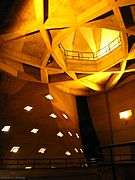
Among the earliest items on display are square flagstones, gold sheeting, and terra cotta tablets from Susa, covered with uniform cuneiform characters. Potteries, ceramics, varnished porcelains (such as a seventh-century blue and gold dish from Gorgan), an illuminated Koran, and miniatures highlight milestones in the country's history up to the nineteenth century, which is represented by two painted panels from Empress Farah Pahlavi's collection.
Events
Audio-visual theater (1971)
The original show, devised in 1971, was replaced in 1975 by a new one which invited visitors to discover Iran's geographic and natural diversity along with its fundamental historical elements. The landscapes and works of art, the faces and achievements, calligraphed poems and technical undertakings, the life and hopes of a population were shown through its ancient miniatures as well as through the smiling studiousness of Iran's new generation of children. This creative "sound and light" performance, devised by a Czechoslovak company, required 12,000 meters of film, 20,000 color slides, 20 movie projectors, and 120 slide projectors. Five computers operated the entire system. The audio-visual programs were carried out under the guidance of professor Jaroslav Frič (1928–2000).[6]
Gate of Words light show (2015)
The German artist Philipp Geist organized a projection mapping installation named Gate of Words at the Azadi Tower, on the occasion of the German Unity Day.[9] The show was held from October 3 to 5, 2015.
In this project, the artist visualized the topics of freedom, peace, space and time in a poetical manner. Geist developed a light installation made of colored words and concepts in different languages, and abstract painterly compositions of images. The glowing words were in English, German and Persian moving in sync with live music on the walls of the tower.[10]
Gallery
-
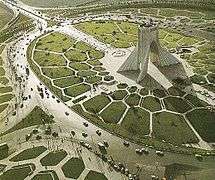
A view of Azadi Square in 1971
-
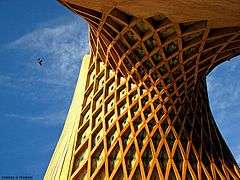
Azadi Tower - Architect: Hossein Amanat - Photo: Arash G Tehrani
-

Azadi Tower - Architect: Hossein Amanat - Photo: Arash G Tehrani
-
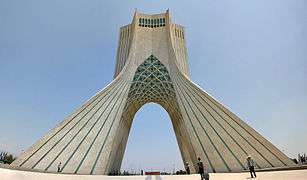
A panorama of the tower
-

Azadi Tower at night
-
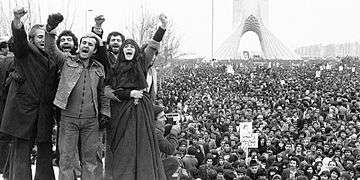
During the Revolution of 1979
-

During the Green Protests
-
A view of the Azadi Tower, with Milad Tower in background
-

Azadi Tower in September 2013
-
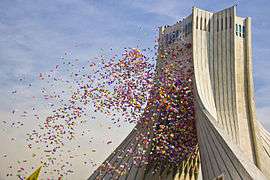
Azadi Tower in February 2014 during Anniversary of the 1979 Revolution
-
Gate of Words show, performed at the Azadi Tower in 2015
-
.jpg)
Azadi Tower in April 2016
-
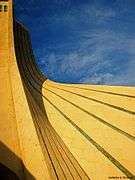
Azadi Tower - Architect: Hossein Amanat - Photo: Arash G Tehrani
-

Azadi Tower - Architect: Hossein Amanat - Photo: Arash G Tehrani
Junctions
External links
See also
| Wikimedia Commons has media related to Azadi Tower. |
References
- ↑ "MEED". Middle East Economic Digest. 15. 29 October 1971.
- ↑ "Hossein Amanat with Benjamin Tiven". Bidoun. Retrieved 24 May 2015.
- ↑ Grigor, Talinn (2003). "Of Metamorphosis Meaning on Iranian Terms". Third Text. 17 (3): 207–225.
- ↑ "BBC فارسی - ايران - 'برج آزادی پس از۲۰ سال شسته می شود'". bbc.co.uk. Retrieved 1 September 2015.
- ↑ http://www.cbc.ca/news/citizenbytes/2009/06/iran_monument_daughter_of_the_1.html
- 1 2 Khashayar, Hemmati, (2015-08-20). "A Monument of Destiny: Envisioning A Nation's Past, Present, and Future Through Shahyad/Azadi". summit.sfu.ca. Retrieved 2016-02-28.
- ↑ "Yahoo News - Latest News & Headlines". news.yahoo.com. Retrieved 1 September 2015.
- ↑ Hureau, Jean. Iran Today, 2nd. Ed, editions j.a.
- ↑ The Guardian: German artist lights up Tehran's freedom arch – in pictures. 7 October 2015.
- ↑ Philipp Geist was invited by the German Embassy to propose such a project at the occasion of the 25th anniversary of the German Reunification.

